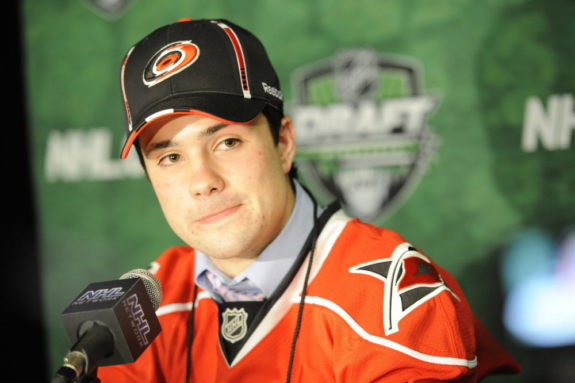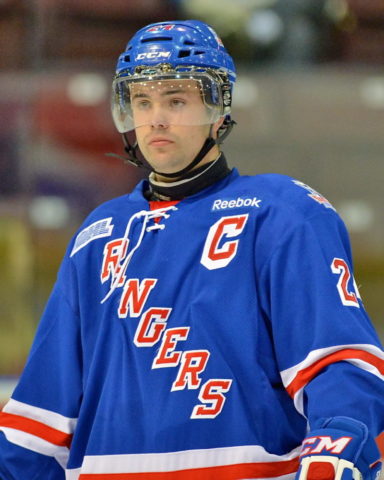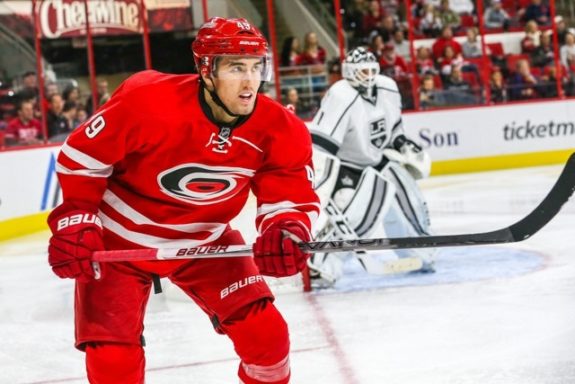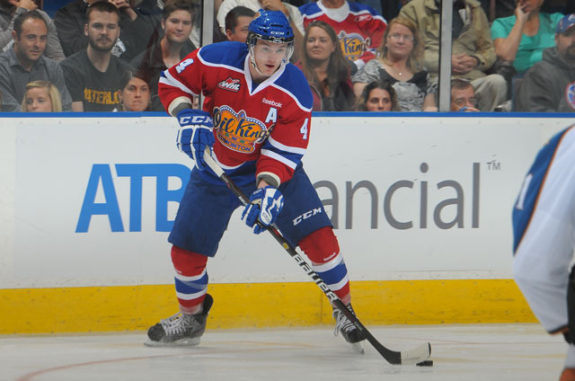I’ve decided it was time to re-commence my grading of previous Carolina Hurricanes draft classes, and for today’s installment, we’ll go all the way back to 2011. As you may or may not remember, the 2010-11 season was when the Hurricanes had their destiny in their own hands in the final game of the regular season. A win would’ve put them in the playoffs – but instead, an embarrassing 6-2 loss at home sealed their fate and ultimately was the start of a long-term rebuild (though we didn’t realize that at the time).
Related: A Look Back: Grading the Canes’ 2014 Draft Class
The Hurricanes only had six picks in the 2011 draft, as they’d traded their fifth-round pick in a deal to re-acquire veteran Corey Stillman, who contributed 16 points in 21 games during the team’s playoff push that spring. Despite being short one pick, the Canes still had solid draft capital to build a strong class, including a lottery pick that became 12th overall. Let’s dive into the history books.
First Round
12th Overall: D Ryan Murphy
The one thing I will absolutely never forget about Ryan Murphy is when, on an episode of Coach’s Corner in late 2010, Don Cherry proclaimed that he would take Murphy with the first overall pick in the draft – and compared him to Bobby Orr. Yes, he was Cherry’s #1 rated prospect in a draft that included the likes of Ryan Nugent-Hopkins, Gabriel Landeskog, Jonathan Huberdeau, Mika Zibanejad, Dougie Hamilton and others. He quoted Murphy as being “worth the price of admission.”
But was he worth the price of the 12th overall pick that the Canes used to select on him? History would suggest the answer to that is an emphatic “no.” At the time, the only defenseman on the roster who was under the age of 25 was Jamie McBain, and their prospect group at the position was largely unknown (and in hindsight – downright bad) at the time. So Murphy was pegged to be the team’s future on the back-end, after his 26-goal, 79-point season as a 17-year old in the OHL inspired optimism that he could be an offensive weapon in the NHL someday.

Unfortunately for Murphy, the things that worked for him successfully at the junior level didn’t translate to the pro game at all, and in turn, he was left as an undersized 5-foot-10, 180-pound defender who lacked anything dynamic about his game. The major downfall for him was that as a 165-pound defender at the OHL level, his skating ability was elite, and he could beat anybody 1-on-1 with his agility and superb two-step acceleration. But when he got to the pro level he had to add weight, and in turn, he lost that top gear he had. Therefore his skating was just “good” in the NHL while still being undersized at 185 pounds – and Hurricanes fans never got to see the elite ability that looked so effortless for Murphy in junior.
So what the Canes were left with was an undersized defender who – after dealing with concussion issues – avoided all physical contact and became a major liability in his own zone. He was fine as a puck-mover, but Justin Faulk’s presence on the powerplay made him a little obsolete, and his ability to create anything at 5-on-5 was often neutralized by the opposition over-powering him physically.
That left Murphy as a tweener – a guy who couldn’t defend against the top line and too small to withstand a forecheck, without any dynamic offensive abilities left to offset his shortcomings. He never played more than 48 games in a single season for the Hurricanes and was routinely passed over by the likes of Klas Dahlbeck and Matt Tennyson, as well as mid-round picks like Jaccob Slavin and Brett Pesce.

I tried my absolute hardest to convince myself that this pick was worthy of more than an F because I mean, he did play 151 games for the team. But he was a lottery pick during a time where the Canes had little hope in the system and was pegged to be the building block to re-shape their entire defense around in the future. But from day one, he just never looked like an NHL talent, and for many, this pick defined the later years of the Jim Rutherford era.
Grade: F
Second Round
42nd Overall: C Victor Rask
This is a tough one to grade because there’s a lot of good but a lot of bad with Victor Rask’s overall time in the Hurricanes’ organization. While his play never progressed as was expected, and his contract became an anchor, he did play 346 games for the team and was eventually traded for Nino Niederreiter in one of the all-time great trades for the team.
Considering that Rask was selected in the middle of the second round, this was a decent value pick. The Canes got a player who contributed for five years in their organization and posted 163 points during his time with the team. His first two seasons were particularly impressive, and after posting 48 points in 80 games during the 2015-16 season – which was second on the team – he looked to be an emerging player who’d fit into their long-term top-six forward group.

The problem was, the years when Rask looked good, the Hurricanes overall were bad. And when the team added legit young talent like Sebastian Aho and Teuvo Teravainen and as a group started to get better, it became apparent that Rask was a product of his previous environment. His production (as well as his role) slowly began to dip, and when Rod Brind’Amour took over as head coach in 2019, Rask became a fourth-liner who was making four million dollars per season.
The problem for Rask was that he just wasn’t great at anything. He was just OK at everything, and his lack of pace became a problem as the Canes’ system evolved into more of a speed-oriented approach. He was a step slow as a skater and lacked any dynamic or go-to moves as an attacker. His vision was solid, and he could move the puck well on the powerplay, but his shot was underwhelming, and he never used his size well for a guy listed at 6-foot-2, 195 pounds.
The best thing to come of the Rask era was when the Hurricanes shed his 6-year, 24-million dollar contract in a one-for-one swap for Nino Niederreiter. Since that trade, Rask has scored 17 goals and 39 points across 119 games for the Minnesota Wild. Niederreiter alone in the 2020-21 season eclipsed Rask’s goal total, as he scored 20 goals on his own for the Canes this season. Since his arrival to Raleigh, Nino’s potted 45 goals in 155 games – which is more goals than Rask’s entire point total – as well as 48 assists, for 93 points total.
The trade has become grand larceny for the Hurricanes, although I’m having trouble deciding if I should include the deal in the overall grade or not. The timeline is as follows: Jim Rutherford drafted Rask in 2011, Ron Francis gave him the big extension in 2016, and Don Waddell erased the mistake and turned water to wine in 2019. Regardless, Rask was a solid contributor to the Canes for a number of years and became the centerpiece of one of the best trades in team history. That warrants a solid grade for me.
Grade: B
Third Round
73rd Overall: D Keegan Lowe
The son of Hockey Hall of Famer Kevin Lowe, the Hurricanes took his son Keegan in the third round, and you’d be hard-pressed to convince anybody that his career has lived up to his father’s footsteps. In Keegan, the Canes saw promise in the 6-foot-2, 195-pound stay-at-home defenseman, who was not shy of physical play and had no problem standing up for teammates.

Though the physical elements to his game were intriguing, the problems that plagued Lowe at the pro level were far more impactful. He lacked any real offense to his game, even in junior, and it never developed further. He struggled as a puck mover and was an average skater at best, which made his potential ascension to the NHL impossible, even at a time where the Canes had very little young talent on defense. He was passed over for chances by the likes of Ryan Murphy, Rasmus Rissanen, Danny Biega and Michal Jordan.
In total, Lowe played 237 games for the Charlotte Checkers over four seasons and played 2 games for the Canes in the 2014-15 season. He did fight Vincent Lecavalier twice – in the same game – during his NHL debut, which is the lone memory Canes fans will have of him. But that does count for something and saves him from getting an F grade. Regardless, a third-round pick on a guy who never looked like an NHLer when reaching the pro level is not good business.
Grade: D
Fourth Round
103rd Overall: RW Gregory Hofmann
I feel like the only reason Caniacs know who Gregory Hofmann is, is because he was the guy that they drafted with the pick directly ahead of Calgary taking Johnny Gaudreau. The Hurricanes drafted Hofmann out of Switzerland, and he’s always been an undersized, offensive-minded winger who can skate like the wind.
He spent ten years in the Hurricanes’ organization, never progressing beyond just coming overseas for rookie and training camps. The Swiss league is absolutely fantastic for local players, so it’s no surprise that Hofmann never wanted to leave his situation there to ride buses in the AHL for lesser pay. He’s emerged as one of the best offensive players in that league over the past few seasons, but the Canes were understandably reluctant to give him the one-way deal he wanted, and so they traded his rights to Columbus in February 2021.
It’s possible that Columbus will grant Hofmann a one-way deal, and he’ll be given a look in the NHL next season. I’m curious to see if that happens this summer. He’s always been a fun player to track, and I hope he has success. The Hurricanes did add a 2022 seventh-round pick for him, so that’s something. But his 10 years in the organization were largely uneventful and, despite the promise, never signed an entry-level deal, and therefore never played a single game in the Canes’ pro system.
Grade: D
Sixth Round
163rd Overall: G Matt Mahalak
There isn’t really much to be said about Mahalak. He was a 6-foot-3, 180-pound goaltender playing in the OHL, whom the Hurricanes’ scouts must’ve seen *something* in. Whatever that was, they obviously didn’t see enough progress in him over the next two years to sign him – and they let his rights expire on June 1, 2013. Afterwards, Mahalak went on to play one more season in the OHL before going to the University of P.E.I., where he played four seasons and got his education. He retired from his playing career after that, and to date has never signed a pro hockey contract.
Grade: F
Seventh Round
193rd Overall: RW Brody Sutter
Another player without much real upside, the only things Brody Sutter had going for him was his size (6-foot-5, 205 pounds) and his last name (yes, he’s part of that Sutter family). Considering he was only a seventh-round flier, you can’t really be upset with this selection. Sutter had some potential to develop into a two-way power forward in the NHL, but ultimately his lack of foot speed and hands of stone held him back, although he did manage to suit up for 12 games in the organization. He also played 219 games for Charlotte and was an important player there, so this pick was OK value – all things considered.
Grade: C
Draft Recap
I guess I’ll recap this draft class because that’s what writers do, but in all honesty, this class speaks for itself. It was quite terrible. Theoretically, the players selected in 2011 should currently be in their prime NHL years, and the Hurricanes have absolutely nothing to show from their class overall. Their lottery pick was a total bust, and while the middle rounds of the drafts are always a crapshoot, they left multiple players who became impactful NHLers on the board in every round.
The only good thing to come from this draft class was obviously the acquisition of Nino Niederreiter, but considering the Jim Rutherford regime that ran this draft had absolutely zero impact in making that deal, I’m not going to use the trade as leniency on this draft grade. It was a brutal draft in hindsight and a major reason for the Hurricanes’ struggles during their nine-year playoff drought – and ultimately Jim Rutherford’s departure.
Draft Grade: D